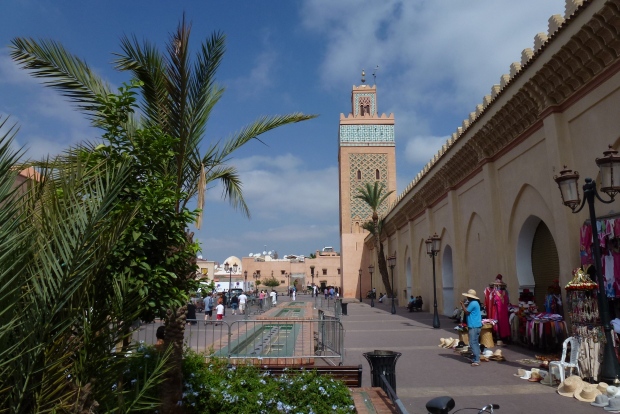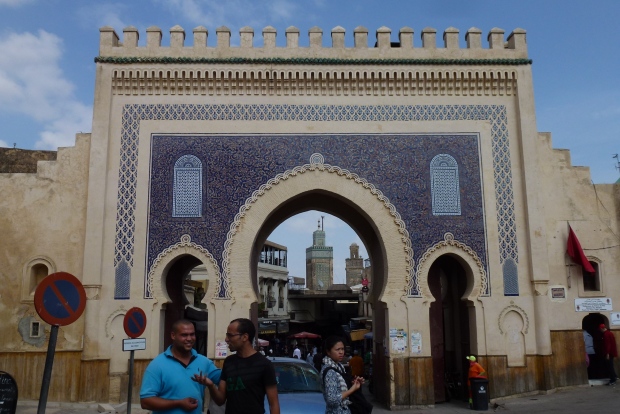Thankfully, Morocco is a country that is not yet overrun by tourists. It is a land of surprising variety, including a long coastline along the Mediterranean Sea and Atlantic Ocean, high rugged mountains (which get snow in the winter), vast deserts, and amazing jagged gorges, oases and beautiful ksars (villages) and kasbahs (noble person’s “castle” or home).

The Atlas Mountains.

The stark contrast of the green palms with the dry mountains near Todra Gorge.
Given the beautiful natural scenery, ancient cities, villages, and friendly people, it’s not surprising that Morocco hosts a lot of movie crews.

A movie studio in Ouarzazate.
Gladiator, The Mummy, The Son of God, Kingdom of Heaven, Black Hawk Down, Alexander, Sodom and Gomorrah and many other movies set in historical and Middle East locations have Moroccan backdrops.

Tamdaght Kasbah, near Ait Ben Haddou, where the surrounding countryside and ksars were used in the filming of the movie Gladiator, with Russell Crowe.
In fact, while we were there, Tom Cruise and Simon Pegg were filming the next Mission Impossible movie in Rabat, the capital city. We just happened to come upon some chase scenes being filmed in the old part of Rabat with Tom Cruise at the wheel of a BMW.

Tom Cruise at the wheel with Simon Pegg next to him, filming in Rabat.
Most of the tourists seemed to be hanging out in Fez and Marrakech. Outside those locations the country felt almost untouched.
We highly recommend Morocco as a bucket list destination. Here are some things to know if you decide to visit Morocco:
Parlez vous français? In addition to Arabic, many Moroccans speak French, since Morocco was a French colony for many years. When locals first meet you, they will assume you speak French. It’s certainly possible to get by on English, but you may end up using a lot of gestures to get your message across. A little French vocabulary (if not Arabic) is valuable, or brush up on your Berber, also spoken in many mountain areas.

The lower two lines are in Berber, in the holy town of Moulay Idriss.
Getting Around. Morocco is not a difficult country to navigate on your own. Auto is the best way to see the country. The roads generally are in very good condition and signs are in Arabic and French, so they are not hard to read. Except in the towns, roads are well signposted.

Our rental car in Morocco.
In the towns and cities, drive carefully – you see all kinds of vehicles and foot traffic (although autos have the right of way), call ahead to your accommodation for specific directions and you should not have any problems.

Typical road sign.
Note: There are speed traps along the highways so be careful and stick to the speed limit, even if its open road. We spent two weeks driving around the country, being very careful with our speed. On our last day I got nailed with a speeding ticket, in a ridiculously slow section of road outside a small town. The police have radar cameras and you will be fined on the spot, so carry some cash. My ticket cost about $35. Gas at the time was about $4 gallon. We had a diesel powered vehicle and got great mileage. Traveling continuously for two weeks cost us about $150 for diesel.

Locations we visited in Morocco are highlighted. We flew in and out of Casablanca.
There are a few trains, but only between the larger cities. The other way to see the country would be with a tour group. We did not see many large tour buses, mainly smaller groups in vans.
Accommodation and Cost. The country is relatively inexpensive for accommodations (most common are small guest houses called Riads). Most of our Riads were about $75/night for very nice rooms, most with breakfast included and wifi.

Typical Riad room, this one is in Rabat.
Every host was very kind and observed the local custom of offering tea and biscuits on arrival.

The tea and biscuit welcome at our Riad in Fez.

Our room in Fez.
Food. We thought the food was decent (and inexpensive), it’s just pretty much the same everywhere you go. Most restaurants serve the same kinds of food: brochettes, salads, frites (fries), and tajines (clay pot slow cooked dishes).

Typical Moroccan meal – the food is generally very good.

Typical Moroccan menu.
After a couple weeks, it gets a bit monotonous. There is the occasional Pizza Hut or McDonald’s, but they are just in the big cities.
Religious Observance. The prevailing religion is Islam. Most mosques and some monuments are off limits to tourists, but other shrines are open to tourists. Your guidebook can point these out.

Mausoleum of Moulay Ismail, one of the few active Muslim shrines that non-muslims may visit, in the city of Meknes.
It’s a good idea to be aware of the local festivals that may be occurring during your visit. We had a very interesting one while we were there that I will explain in a future post.
Baksheesh. Plan on paying lots of small tips for all kinds of services (porting your luggage, getting directions, etc.). This is similar to Egypt and India and many other less developed countries.
Safety and Other. The country felt very safe, we never had any cause to worry. Follow the usual precautions of protecting your valuables, knowing your surroundings and not displaying expensive jewelry or loads of money. The larger cities are somewhat chaotic (for example, crowds, rubble, interesting smells), but not nearly to the extent one finds in India.

Argan oil for sale – used for a number of skin and hair applications.
Shopping is good for certain things – ancient sea fossils, argan oils, spices and leather goods can be found in abundance.









































































































































